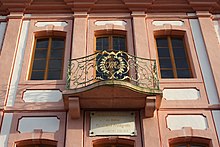Freiligrathhaus
The Freiligrathhaus is a baroque mansion in the town of Unkel am Rhein , in which the poet of Vormärz, Ferdinand Freiligrath, lived between 1839 and 1840. From here he ran his campaign to rebuild the Rolandsbogen and became a political poet and champion of democracy in Germany.
The at Unkel Rhine promenade lying Palais was from 1750 to 1778 for the family of the Barons of Bushmen who at that time Electorate of Cologne presented Chancellor and city counts of Cologne were built. The important baroque building shows parallels to some of the contemporary buildings in Koblenz and the influences of the master builders Balthasar Neumann , Johannes Seiz and Nikolaus Lauxen . In particular, the close parallels, which go down to the last detail, to his design for a garden pavilion in Randersacker, executed around 1750, speak for a direct influence of Balthasar Neumann . Lauxen, known for his illusion painting, is attributed the color scheme of the facades and the completion of the interior fittings. Findings suggest that Lauxen did not complete the building designed and started by Balthasar Neumann and Johannes Seiz in the 1750s until the 1770s, after interrupting construction and changing plans. The recently completed palace was hit by the devastating ice flooding of the Rhine in 1784. The inscription in the keystone of the archway of the former "Bridge of Sighs", which once connected the house with the Rhine garden to the north, still tells of this. Lauxen can also be considered for repairing the damage and restoring the facades.
The three-storey plastered building with a mansard roof , built in quarry stone on an older basalt foundation of a gate of the medieval city wall, has a five- axis pilaster-structured Rhine front with a wrought-iron balcony parapet from the Rococo that is of the highest mastery. The three central axes carry a pilaster- shaped dwelling with a curved gable , which can be found in a similar form on the Koblenz buildings by Seiz and Lauxen. Today's original version of the facades is the result of a reconstruction that was carried out with great effort from 2008 onwards using the original findings, including the remains that have been preserved.
The former Electoral Cologne Palace got its current name from the stay of Ferdinand Freiligrath, who began his life as a freelance poet and political thinker on one of the upper floors as a tenant of the Cologne family von Monschau-Erlenwein after his initial successes . At times he lived there with his dog the Strolch and his horse Sultan, who both found their way into the poetry of German Romanticism as literary figures , and some friends, including Levin Schücking , in one of the earliest residential communities in Germany, which was characterized by democratic ideals of freedom. Later, the family of the composer Carl Loewe with his son-in-law James Arthur Hepburn von Bothwell, a descendant of James Hepburn, 4th Earl of Bothwell , the third husband of Mary Queen of Scots , resided in the mansion, which was now supplemented by some elements of English neo-Gothic . Due to the ties between the Freiligrath and Loewe families, as well as a memorial set up in the house for the famous composer, the property was also known under the name Freiligrath-Loewe-Haus until the 1920s. The last direct descendants of the Loewe and Bothwell families living in the house were members of the opposition Confessing Church of the Rhineland during the National Socialist era . Other residents and regular guests of the house were the electoral councilor Kaspar Josef von Biegeleben , the imperial personal physician Anton de Haen , the Bonn professor, scholar and Germanist Karl Simrock , the family of the 1st Cologne mayor of Monschau-Erlenwein , who added them around 1810 Initials still adorn the balcony on the Rhine side today, Johann Wolfgang von Goethe , Josef Arens , Stefan Andres and many more.
From 1945 to the 1960s, the palace served as a place of worship based on testamentary decrees of the Evangelical Community in Unkel until its own church was built.
Konrad Adenauer , who temporarily found refuge in neighboring Paxheim during the Nazi era, and Willy Brandt , who later took up residence in the vicinity of the house, were among the visitors to the house .
literature
- Claudia Euskirchen: Nikolaus Lauxen (1722–1791). A builder of the Rhenish-Moselle Baroque. (= Pulheim contributions to history and local history. 16th special publication). Pulheim 1997, ISBN 3-927765-21-X .
- Hans Vogts, Franz HermannKemp: City of Unkel. (= Rheinische Kunststätten. Issue 106). 5th edition. Rhenish Association for Monument Preservation and Landscape Protection, Cologne 1987, ISBN 3-88094-557-8 , p. 17.
Web links
Coordinates: 50 ° 35 '57.6 " N , 7 ° 12' 50.9" E


